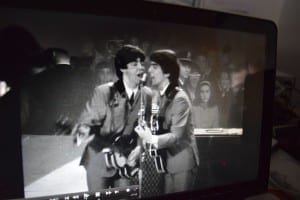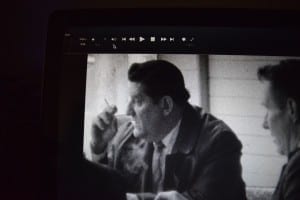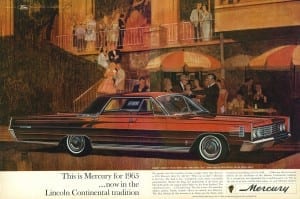1960s-era documentary films by the Maysles brothers and The Meaning of Human Existence (2014)
This post is concerned with 1960s-era films by Albert and David Maysles.
The post also appears as an update to an earlier post entitled:
The Meaning of Human Existence (2014)
I’m posting the update as a separate item in order to bring attention to it. I’ve also edited the original update and added links. In the process, I’ve been reminded – in this case regarding my own recollections of the 1960s – of the malleability of memories.
1960s cars

Image from the groundbreaking (because of its approach to cinematography) Maysles 1960s documentary about the first Beatles visit in 1964 to America and their appearances on the Ed Sullivan Show. Several Maysles DVDs are available at the Toronto Public Library.
Among other topics, which include gentrification, displacement, genocide, evolutionary biology, and the world history of warfare, the above-noted post discusses The Long 1968: Revisions and New Perspectives (2013). With regard to the 1960s era, a groundbreaking documentary that came out in 1964 is Beatles: The First U.S. Visit by Albert and David Maysles. Another first-rate film by the Maysles brothers that captures aspects of the era is Salesman. The documentary focuses upon a team of smoking, door-to-door Bible salesmen travelling from town to town in their now-vintage, 1960s-era cars to sell their wares.
The film about the Beatles similarly highlights smoking. In some ads of that era, doctors were portrayed as extolling the “mildness” or other admirable qualities of particular bands of cigarettes, as I recall.
Again, if I recall correctly, until somewhere around the 1980s, staff rooms at Canadian schools were typically filled with cigarette smoke until the day arrived that smoking was banned in schools, stores, and restaurants.
It occurs to me that the expression “Sugar is the new tobacco” is of interest as is the expression “Sitting is the new smoking – even for runners.” [By way of an update regarding the latter topic, subsequent research reports indicate that an hour a day of strenuous exercise is capable of addressing the health-related effects of eight hours per day of sitting.]
In Canada, we’ve been a little slower dealing with asbestos than with tobacco. I recall around the late 1950s, when little was apparently known about the health risks associated with the product, that we used asbestos as modelling paste in a craft project at Morison School. Each person in the class made a little wishing well from a large tin can. The asbestos paste was used to construct an outer surface for the well. A little roof was constructed out of wood. The well that I had constructed, in that class, spent some years at our house on Lavigne Street, I think in the basement, before I threw it out.
The Maysles documentaries adopt a “direct” approach to cinematography which stands in contrast to a strategy adopted by the National Film Board.
Updates
A June 8, 2015 CBC article is entitled: “Huge tobacco fines could set stage for more aggressive anti-smoking efforts: Companies say they will appeal decision that orders them to pay $15B in damages.”
A caption for the lead photo for the article notes that “The number of Canadians smoking has fallen from about 50 per cent in the mid-1960s to about 20 per cent of people over the age of 12 in 2013.”
A June 12, 2015 CTV News article is entitled: “Paul McCartney wows concert-goers one week before his 73rd birthday.”
A March 16, 2016 statnews.com article is entitled: “Despite your fancy standing desk, you’re still sitting too much.”
A March 21, 2016 Quartz article is entitled: “There’s not enough evidence to say standing desks are good for your health.”
Grey Gardens
The first Maysles brothers film that I recently saw was Grey Gardens, which has become a cult classic.

Image from “Salesman,” 1960s Maysles brothers documentary. The salesmen are shown driving to visit their prospective clients in 1960s-model cars. As in the 1960s Beatles film, people are observed smoking cigarettes everywhere, indoors and outdoors and in cars. They’re smoking all the time even when sitting in suburban kitchens or living rooms selling Bibles.
In the late 1970s and in the years that followed I sometimes thought about the fact that NFB films always embodied the same look and feel.
When I recently began to view documentaries by the Maysles brothers, I quickly came to understand why, indeed, all NFB productions are similar in their effect upon the viewer.
The early history of the Film Board accounts for the enduring structure of its films. During the Second World War, the Board played a necessary and important role in wartime propaganda. Every NFB film embodies a carefully crafted, intended message; such an approach accounts for its strengths and limitations. The question that arises is: “So, what if I don’t want to be subjected to a message? What alternatives are available for me as a viewer of documentaries?”

Two-page magazine spread for 1965 Ford Mercury. The ad is discussed at another previous post. If you click on the image, then click again, you’ll note that several smartly dressed individuals are depicted holding a cigarette.
Additional Updates
The role of film producers is of interest.
An April 9, 2015 New York Times article is entitled: “‘Disorder’ and ‘Stray Dogs’ Capture the Look of Cities Falling Apart.”
An excerpt reads:
- For 58 minutes, “Disorder” bombards the viewer with interwoven bulletins, presented without comment. Many are grotesque human-interest stories: Shops peddle illegal bear paws; escaped pigs roam the highway; a cockroach emerges from a bowl of noodles. One man brandishes what looks like a live crocodile, another washes himself in a polluted tributary of the Pearl River. Other sequences are more violent recordings of arguments and breakdowns. Civilians brawl with the police, and the movie ends with a remarkable sequence of cops beating a man nearly to death.
[End of excerpt]
A July 27, 2016 Guardian article is entitled: “One hour of activity needed to offset harmful effects of sitting at a desk: Risk of dying increases among desk-based workers who sit for eight hours and do low amounts of exercise, new research finds.”
Click on each image to enlarge it. Click again to enlarge it further.

Leave a Reply
Want to join the discussion?Feel free to contribute!